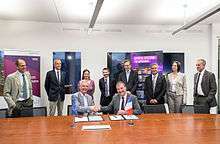Safran
 | |
|
| |
| Société Anonyme | |
| Traded as |
Euronext: SAF CAC 40 Component |
| Industry |
Aerospace Defense |
| Founded | 2005 |
| Headquarters | Paris, France |
Key people |
Philippe Petitcolin (CEO) Ross McInnes (Chairman)[1][2] |
| Products | Aircraft engines and equipment, defence electronics |
| Revenue | €16.521 billion (2017) |
| €2.470 billion (2017) | |
| €2.623 billion (2017) | |
| Total assets | €18.51 billion (end 2010)[3] |
| Total equity | €24.7 billion (March 2016) |
Number of employees | 58,000 (31/12/2017) |
| Website |
www |
Safran S.A. is a French multinational aircraft engine, rocket engine, aerospace-component and defense company. It was formed by a merger between the aircraft and rocket engine manufacturer and aerospace component manufacturer group SNECMA and the security company SAGEM in 2005. Its headquarters are located in Paris. Employing over 58,000 for 16.5 billion euros of sales and 1.4 billion euros R&D expenditures in 2017, Safran operates in the aircraft propulsion and equipment, space and defense markets, is listed on Euronext and is part of the CAC 40 and Euro Stoxx 50 indices.[4]
Name
The name Safran was chosen from 4,250 suggestions. As a holding company for many subsidiaries, the name was deemed suitable for the suggestion of direction, movement, and strategy. Safran translates as rudder blade and as saffron, which the company highlights as one of the catalysts for early international trade.[5]
History
Origins
In 1905 Louis Seguin created the company Gnome. Production of the first rotary engine for airplanes, the Gnome Omega, started in 1909. This company merged with the Le Rhône, a company created in 1912 by Louis Verdet, to form the Gnome et Rhône engine company. Gnome & Rhône was nationalized in 1945, creating Snecma. In 2000, this company gave its name to the “Snecma Group”, and carried out a number of acquisitions to form a larger group with an array of complementary businesses.
Sagem (Société d’Applications Générales de l’Electricité et de la Mécanique) was created in 1924 by Marcel Môme. In 1939, Sagem entered the telephone and transmissions market by taking control of Société anonyme des télécommunications (SAT). It acquired Société de Fabrication d’Instruments de Mesure (Sfim), a measurement instrument specialist, in 1999. However, by 2008 Sagem Mobile and Sagem Communications had been sold. Sagem Mobile became Sagem Wireless in January 2009.
Safran Group
The Safran Group was created on May 11, 2005, with the merger of Snecma and Sagem SA.
In June 2014, Arianespace CEO Stephane Israel announced that European efforts to remain competitive in response to SpaceX's recent success have begun in earnest. This included the creation of a new joint venture company from Arianespace's two largest shareholders: the launch-vehicle producer Airbus and engine-producer Safran.[6]
By May 2015, Safran had created with Airbus Group a launcher joint venture called Airbus Safran Launchers.[7] This entity is currently developing the Ariane 6 launch vehicle for initial flights in the 2020s.[8]
In January 2017, Safran initiated a takeover of the aircraft interior supplier Zodiac Aerospace to create the third largest aerospace supplier with $22.5 billion revenue, behind United Technologies with $28.2 billion and GE Aviation with $24.7 billion; the new group will be 92,000-employee strong, with 48% of its business in aircraft systems and equipment, from landing gears to seats, 46% in propulsion and 6% in defense.[5]
In May 2017, Safran announced the completion of the sale of its identity and security activities to Advent International for Euro 2.4 billion.[9]
In February 2018, Safran took control of Zodiac Aerospace, significantly expanding its aircraft equipment activities. Zodiac Aerospace has 32,500 employees and generated sales of 5.1 billion euros for its fiscal year ended August 31, 2017.[4]
On June 4, 2018, Boeing and Safran announced their 50-50 partnership to design, build and service APUs after regulatory and antitrust clearance in the second-half of 2018.[4] This could threaten the dominance of Honeywell and United Technologies.[10]
Group organization
The Safran group is divided into three main branches:[11]
Aerospace propulsion
.jpg)
The aerospace propulsion branch groups all operations concerning the propulsion of aeroplanes, helicopters, missiles, and launchers, for the civil aviation, military aviation, and space markets: design, production, marketing, testing, maintenance, repair, and overhaul (MRO).
- Safran Aircraft Engines (formerly Snecma Moteurs)
- Commercial & military engines, liquid propulsion for space launchers
- Turbomeca
- Herakles (formerly Snecma Propulsion Solide)
- Solid rocket motors for launchers, strategic and tactical missiles
- Thermostructural composite materials
- Safran Aero Boosters
- Components for aircraft and rocket engines
Other subsidiaries
- Cenco
- Smartec
- SMA Engines
- Snecma Services Brussels
- Snecma Suzhou
- Snecma Xinyi Airfoil Castings
Aircraft equipment
The aircraft equipment branch groups all design, production, sales, and support operations for systems and equipment used by civil and military airplanes and helicopters.
- Safran Landing Systems
- Landing gear design, manufacture, and support
- Wheels and carbon brakes for mainline commercial jets
- Braking control and hydraulic systems
- Safran Nacelles
- Commercial airplane engine nacelles and thrust reversers
- Labinal Power Systems
- Aircraft wiring systems
- Hispano-Suiza
- Mechanical, hydraulic, electronic and electrical equipment
- Safran Engineering Services
- Engineering and consulting company
- Technofan
- Fan designer and manufacturer[12]
Other subsidiaries
|
|
Defense
The defense branch operates in the civil, military, and space markets, and covers the following areas: inertial guidance and navigation equipment (SIGMA INS based on ring laser gyro sensors), optronics systems and equipment, avionics systems, UAV (unmanned aerial vehicle) systems, air-land systems and equipment.
- Sagem
- Technologies and services in optronics, avionics, electronics and safety-critical software
Other subsidiaries
Corporate affairsFinancial information
Shareholder profile
The biggest change in Safran's shareholder profile is the increase in publicly held shares (from 36.9% in 2008 to 54.1% in 2012).[17] See also
References
External links |
